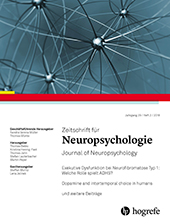Abstract
Zusammenfassung. Neurofibromatose Typ 1 (NF1) ist eine seltene genetische Erkrankung, die neben physischen Beeinträchtigungen maßgeblich neuropsychologische Probleme mit sich bringt. Besonders alltagsrelevant sind hierbei exekutive Dysfunktionen. Bei 30 bis 50 % aller Kinder mit NF1 kann außerdem eine komorbide Aufmerksamkeitsdefizit-/Hyperaktivitätsstörung (ADHS) diagnostiziert werden. Da exekutive Dysfunktionen als eines der Kernsymptome der ADHS gelten, wurde in der vorliegenden Studie untersucht, ob NF1-Patienten generell von exekutiven Dysfunktionen betroffen sind oder nur eine Subgruppe mit komorbider ADHS. Zudem wurde geprüft, ob sich Patienten mit reiner ADHS und Patienten mit ADHS bei NF1 in ihren exekutiven Dysfunktionen ähneln. Es zeigte sich, dass NF1-Patienten ohne ADHS in ihren exekutiven Funktionen nicht beeinträchtigt sind, eine komorbide ADHS jedoch mit exekutiven Auffälligkeiten assoziiert ist.
Abstract. In addition to having physical complications, children with neurofibromatosis type 1 (NF1) show a wide spectrum of neuropsychological deficits, mainly executive dysfunctions. Approximately 30 % to 50 % of NF1-patients are also diagnosed with a comorbid attention-deficit/hyperactivity disorder (ADHD). Since executive dysfunctions are a core component in ADHD, this study was conceived to show whether executive dysfunctions are genuinely a problem in NF1 – or just one of an ADHD subgroup. Additionally, we investigated whether executive dysfunctions in NF1 differ from those observed in pure ADHD. According to our findings, NF1-patients without ADHD do not show any executive dysfunctions; however, NF1-patients with ADHD exhibit serious impairments. These results show that executive dysfunctions are not a core deficit of NF1 but rather one of ADHD.
Literatur
(2000). Regensburger Wortflüssigkeits-Test (RWT). Göttingen: Hogrefe.
(2004). Impact of executive function deficits and attention-deficit/hyperactivity disorder (ADHD) on academic outcomes in children. Journal of Consulting and Clinical Psychology, 72(5),
757 .(2007). Construct validity of parent ratings of inhibitory control. Child Neuropsychology, 13(4), 345–362.
(2016). Parent and Teacher Perspectives on Emerging Executive Functioning in Preschoolers With Neurofibromatosis Type 1: Comparison to Unaffected Children and Lab-Based Measures. Journal of Pediatric Psychology, 42(2), 198–207.
(2008). Assessment of executive functions: Review of instruments and identification of critical issues. Archives of Clinical Neuropsychology, 23(2), 201–216.
(2002). Growth curve analyses of neuropsychological profiles in children with neurofibromatosis type 1: Specific cognitive tests remain „spared“ and „impaired“ over time. Journal of the International Neuropsychological Society, 8(6), 838–846.
(2005). Behavioural, academic and neuropsychological profile of normally gifted neurofibromatosis type 1 children. Journal of Intellectual Disability Research, 49(1), 33–46.
(2007). Impact of executive functioning and symptoms of attention deficit hyperactivity disorder on children’s peer relations and school performance. Developmental Neuropsychology, 32(1), 521–542.
(2013). Modeling cognitive dysfunction in neurofibromatosis-1. Trends in Neurosciences, 36(4), 237–247.
(2006). Executive functions in attention-deficit/hyperactivity disorder. Journal of Clinical Psychiatry, 67(suppl 8), 21–26.
(1999). Epidemiology of neurofibromatosis type 1. American Journal of Medical Genetics, 89(1), 1–6.
(2014). Is there a relationship between execu- tive functions and academic success in children with neurofibromatosis type 1? Neuropsychological Rehabilitation, 24(6), 918–935.
(2000). BRIEF: Behavior Rating Inventory of Executive Function: Professional manual. Lutz, FL: Psychological Assessment Resources.
(1999). Importance of deficits in executive functions. Lancet, 354(9194), 1921–1923.
(2003). The primate basal ganglia: parallel allel and integrative networks. Journal of Chemical Neuroanatomy, 26(4), 317–330.
(2003). Natural history of cognitive deficits and their relationship to MRI T2-hyperintensities in NF1. Neurology, 60(7), 1139–1145.
(2006). Learning disabilities in children with neurofibromatosis type 1: subtypes, cognitive profile, and attention-deficit-hyperactivity disorder. Developmental Medicine & Child Neurology, 48(12), 973–977.
(2009). Klinik und Genetik der Neurofibromatose Typ 1. Medizinische Genetik, 21(4), 519–531.
(1980). A Monte Carlo study of analysis of covariance under violations of the assumptions of normality and equal regression slopes. Educational and Psychological Measurement, 40(4), 835–840.
(2013). Conners 3®: Conners Skalen zu Aufmerksamkeit und Verhalten – 3. Manual. Bern: Huber.
(2012). The adverse influence of attention-deficit disorder with or without hyperactivity on cognition in neurofibromatosis type 1. Developmental Medicine & Child Neurology, 54(10), 892–897.
(2002). Effects of IQ on executive function measures in children with ADHD. Child Neuropsychology, 8(1), 52–65.
(2002). Treatment of ADHD in neurofibromatosis type 1. Developmental Medicine & Child Neurology, 44(03), 164–170.
(2000). Neurofibromatosis type 1. American Journal of Medical Genetics, 97(2), 119–127.
(2002). Review article: cognitive deficits in neurofibromatosis 1. Journal of Child Neurology, 17(8), 605–612.
(2014). Neurofibromin is the major ras inactivator in dendritic spines. Journal of Neuroscience, 34(3), 776–783.
(1999). Cognitive impairment in neurofibromatosis type 1. American Journal of Medical Genetics, 89(1), 45–52.
(2012). Does attention-deficit-hyperactivity disorder exacerbate executive dysfunction in children with neurofibromatosis type 1? Developmental Medicine & Child Neurology, 54(10), 898–904.
(2011). Assessment of executive function and attention in children with neurofibromatosis type 1: relationships between cognitive measures and real-world behavior. Child Neuropsychology, 17(4), 313–329.
(2007). Hamburg-Wechsler-Intelligenztest für Kinder-IV (HAWIK-IV). Bern: Huber.
(2015). The Relation Between ADHD and Cognitive Profiles of Children with NF1. Journal of Pediatric Neuropsychology, 1(1–4), 42–49.
(2012). The impact of ADHD on the cognitive and academic functioning of children with NF1. Developmental Neuropsychology, 37(7), 590–600.
(2008). Executive functions in preschool children with aggressive behavior: Impairments in inhibitory control. Journal of Abnormal Child Psychology, 36(7), 1097–1107.
(1992). Trail Making Test. Manual for administration and scoring. South Tucson, AR: Reitan Neuropsychology Laboratory.
(2003). Neurokutane Syndrome. In M. J. Lentze, F. J. Schulte, J. Schaub & J. Spranger (Hrsg.), Pädiatrie. Grundlagen und Praxis (2. Aufl., S. 1373–1379). Berlin: Springer.
, (2014). Is executive function specifically impaired in children with Neurofibromatosis type 1? A neuropsychological investigation of cognitive flexibility. Applied Neuropsychology: Child, 3(2), 94–102.
(2011). Family socioeconomic status and child executive functions: the roles of language, home environment, and single parenthood. Journal of the International Neuropsychological Society, 17(01), 120–132.
(2006). Neuropsychological functioning in people with ADHD across the lifespan. Clinical Psychology Review, 26(4), 466–485.
(1988). Neurofibromatosis. Conference statement. National Institutes of Health Consensus Development Conference. Archives of Neurology, 45, 575–578.
(1999). Hyperactive Ras as a therapeutic target in neurofibromatosis type 1. American Journal of Medical Genetics, 89(1), 14–22.
(2009). Adjustment of the social class index for application in the german health interview and examination survey for children and adolescents (KiGGS). Wismar: HWS-Hochschule Wismar.



